Agriculture fruit farm business plan for starting your own farm
Do you want to start a fruit farming business? Well, the business mainly sells young fruit plants and seeds, and sometimes mature fruit packs to the customers. The business has never-ending demand as fruit and vegetables are consumed by people of all incomes throughout the year. Besides, the demand for fruit is also high in the industrial sector.
Keeping in view the scope and opportunities in this business, it will truly be a wise decision to enter this venture. However, to make sure that all the aspects of this business are properly structured, there will be a need for writing a strategic business plan. In this blog, we will be providing all details about how to make an agricultural business plan so that you can have help. The details provided in this agriculture fruit farm business plan are of a successful startup, Fruit Land.
Executive Summary
2.1 The Business
Fruit Land will be a registered and licensed fruit farm business based in New York. The business will aim at providing young plants, fruits, and vegetables for domestic as well as commercial purposes.
2.2 Management of Agriculture Fruit Farm
Fruit Land will be managed by its owner and a co-manager. With combined efforts, they will hire further human resources to help them run their business.
If you are looking for how to start agriculture business you must not ignore the importance of management. Management is an extremely important component of a nursery plant business plan. In your fruit farm business plan you should define the employee hierarchy clarifying the individual roles of every worker of your company. So that your employees know where they have to report.
Besides, it will also help you in establishing a supervised system because plant-related business yields result only in the presence of a disciplined and punctual approach.
2.3 Customers of Agriculture Fruit Farm
In your starting a fruit farm business plan it is essential to identify your customers at an earlier stage. In this blog on how to start a fruit farm business we’re listing the groups of customers identified by Fruit Land.
- Domestic Buyers
- Restaurants
- Fruit Processing Industries
2.4 Business Target
Our major targets are:
- To decrease our expenses and costs of operations by 20% every three years by enhancing business efficiency, productivity, technological support, and innovation.
- To earn a net profit margin of $29.6k per month by the end of the third year.
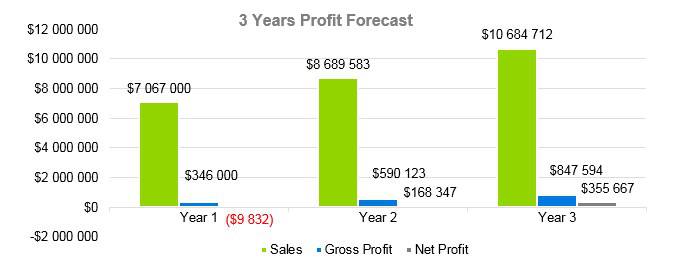
Company Summary
3.1 Company Owner
Fruit Land will be owned by Sean Redford. Sean is a graduate in horticulture sciences with a master’s in business administration. For the past four years, he had been working in a hydroponics company.
3.2 Why the agriculture fruit farm is being started
Sean has extraordinary management skills. He is a man who can make others work with motivation, responsibility, and in a disciplined manner. He decided to start a fruit farm business due to the immense opportunities this field has to provide.
3.3 How the agriculture fruit farm will be started
Step1: Plan Your Business
The first step is to develop start a fruit farm business plan. This step will enable you to formulate your business strategies. That will help you in prioritizing the workforce and expenses of some specific tasks.
Note
In this example of a fruit farm business plan, we will be providing all the details of Fruit Land to help you in identifying the major aspects of this business. This agriculture fruit farm business plan pdf will also help you if you are looking for aquaponic farming business plan or pepper farm business plan. As the workplace and workspace requirements will remain the same. Only market trends and groups of target customers will change.
Step3: Define The Brand
After that, you will have to start procuring the inventory and tools to run your business while also initiating the recruitment phase. This is the time when you define your services, values, and competitive aspects to get recognized in the market.
Step3: Establish Web Presence
To get known to a wider audience you will have to establish a strong website and social media presence.
Step4: Promote And Market
You will have to start advertising your services and products so that your target customers can be attracted to you.
Step5: Estimate Startup Costs
After planning about your business operations, the next step is to estimate your startup costs. It is to estimate the additional money you require to start your business. In case you are low on investment, you’ll have to explore how to write a business plan for bank loan.
To give you an idea of the costs involved in starting this business, we’re attaching the startup costs of Fruit Land in this fruit farm business plan sample.
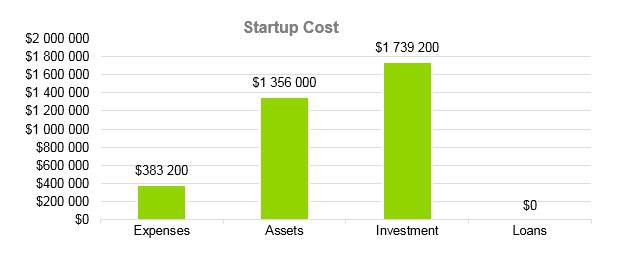
| Start-up Expenses | |
| Legal | $245,000 |
| Consultants | $0 |
| Insurance | $27,000 |
| Rent | $40,000 |
| Research and Development | $21,000 |
| Expensed Equipment | $46,000 |
| Signs | $4,200 |
| TOTAL START-UP EXPENSES | $383,200 |
| Start-up Assets | $366,000 |
| Cash Required | $380,000 |
| Start-up Inventory | $50,000 |
| Other Current Assets | $270,000 |
| Long-term Assets | $290,000 |
| TOTAL ASSETS | $1,356,000 |
| Total Requirements | $1,739,200 |
| START-UP FUNDING | |
| Start-up Expenses to Fund | $383,200 |
| Start-up Assets to Fund | $1,356,000 |
| TOTAL FUNDING REQUIRED | $1,739,200 |
| Assets | |
| Non-cash Assets from Start-up | $1,772,000 |
| Cash Requirements from Start-up | $395,000 |
| Additional Cash Raised | $59,000 |
| Cash Balance on Starting Date | $33,900 |
| TOTAL ASSETS | $2,259,900 |
| Liabilities and Capital | |
| Liabilities | $30,000 |
| Current Borrowing | $0 |
| Long-term Liabilities | $0 |
| Accounts Payable (Outstanding Bills) | $39,000 |
| Other Current Liabilities (interest-free) | $0 |
| TOTAL LIABILITIES | $69,000 |
| Capital | |
| Planned Investment | $1,739,200 |
| Investor 1 | $0 |
| Investor 2 | $0 |
| Other | $0 |
| Additional Investment Requirement | $0 |
| TOTAL PLANNED INVESTMENT | $1,739,200 |
| Loss at Start-up (Start-up Expenses) | $451,700 |
| TOTAL CAPITAL | $2,190,900 |
| TOTAL CAPITAL AND LIABILITIES | $2,259,900 |
| Total Funding | $1,739,200 |
Services
Defining your services in your fruit farm business plan is essential. It is a step that enables you to plan how you will be delivering the specified services. How much will be the costs for providing your services and what type of workforce you will be requiring for implementation. In this business plan agriculture farm download pdf we’re listing the services of Fruit Land. If you’re looking for a general farm business plan, organic fertilizer business plan, or fruit farm business plan you can benefit from here.
- Young Fruit Plants & Seeds: Our primary service will be to provide fruit seeds and young fruit trees, and plants. We will be offering this service for all types of fruit ranging from common fruit like apples to rare fruit like Feijoa.
- Young Vegetable Plants & Seeds: We will also sell the seeds and plants of almost all types of vegetables.
- Ripe Fruit & Vegetable Varieties: We will be offerings packs of ripe fruit and vegetables that have immense demand in our vicinity. Our ripe fruit offerings will include:
- Apples
- Mangoes
- Pineapples
- Oranges
- Loquat
- Raspberries, Strawberries, Blackberries, Blueberries, Cranberries, Golden Berries, Mulberries
- Cherimoya
- Grapes
- Pineapple
- Cherries and more.
Our ripe vegetable varieties will include:
-
- Onions & Green Onions
- Spinach
- All varieties of Potato
- Broccoli
- Mushrooms & more.
- Fertilizers & Farming Essentials: We’ll sell all the farming and agriculture essentials including
- Organic Fertilizers
- Sprayers
- Mowers
- Sickle
- Hydroponics Equipment
- Garden Tools
- Miscellaneous Items
Marketing Analysis of Agriculture Fruit Farm
Before setting up a fruit farm business it is essential to carry out a marketing analysis. Doing an accurate marketing analysis will enable you:
- To identify your customers and thus their demands and expectations.
- To study the market trends, previous and forecasted profit margins, market size, etc.
- To explore the already-established market giants to adopt ways to outperform them.
- To figure out a middle ground between your fruit farm business profitability targets and the suitable price above which you won’t be achieving sales targets
Considering the importance of accurate marketing analysis, Sean hired a temporary marketing analyst to analyze the in-demand trends. In this business plan for farming and agriculture, we’re providing the marketing analysis of Fruit Land.
5.1 Market Trends
UK Start-Up Visa Business Plan
The fruit farm business is not expected to suffer a decline in the coming years. It is because fruits are eaten and used in many restaurants and food industries. According to IBISWorld, fruit and nut farming businesses in the United States are currently holding a market size of $26 billion. Moreover, there is 1% room for growth in the industry in 2021.
5.2 Marketing Segmentation
If you are looking for how to start a fruit farm business you should first identify your customers. Listing the groups of your target customers in your starting a fruit farm business plan will help you in analyzing their buying patterns.
The customers of Fruit Land will belong to these groups:
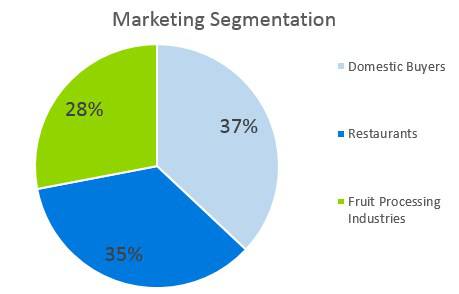
5.2.1 Domestic Buyers
Our primary customers will be the individuals and families living in New York City. They are expected to purchase ripe fruit and vegetable varieties as well as plants from us.
5.2.2 Restaurants
The second group of our target customers comprises restaurants that use fruit and vegetables to prepare their products. They are expected to buy from us in bulk.
5.2.3 Fruit Processing Industries
The third target group comprises the food industries that use fruits to prepare products. They will need our products for making fruit jams, canned fruit, salads, and other items.
| Market Analysis | |||||||
| Potential Customers | Growth | Year 1 | Year 2 | Year 3 | Year 4 | Year 5 | CAGR |
| Domestic Buyers | 37% | 52,000 | 54,000 | 56,000 | 57,000 | 58,000 | 10.00% |
| Restaurants | 35% | 48,000 | 49,000 | 51,000 | 53,000 | 54,000 | 10.00% |
| Fruit Processing Industries | 28% | 39,000 | 40,000 | 41,000 | 43,000 | 45,000 | 11.00% |
| Total | 100% | 139,000 | 143,000 | 148,000 | 153,000 | 157,000 | 10% |
5.3 Business Target
Our business targets are
- To decrease our expenses and costs of operations by 20% every three years.
- To earn a net profit margin of $29.6k per month by the end of the third year.
- To achieve and maintain a CSAT score above 90% within a year of our launch.
5.4 Product Pricing
Great service
Great service. Good turnaround time and quality work.
Thanks!
Our prices are very reasonable and lie within the same range as that of our market competitors.
Marketing Strategy of Agriculture Fruit Farm
To make sure that you get enough customers, you’ll have to develop a marketing plan for fruit farm business. In this part of your fruit farm business plan, you have to also analyze your monthly and yearly sales.
6.1 Competitive Analysis
Our competitive advantages are listed here:
- Our fruit, seeds, and plant offerings are more than any other fruit farm in the entire New York. As we are also selling rare fruit varieties like Golden Berries, Cherimoya, etc. we expect to gain more customers than our competitors.
- Besides the fruit, we’re also providing organic fertilizers, farming equipment, and hydroponics equipment. A fact that will help us boost our sales.
- Lastly, our policies are highly customer-care oriented. We will go all out to ensure customers’ satisfaction.
6.2 Sales Strategy
- We’ll advertise our startup through Google Local ads service, social media, and newspaper.
- We’ll offer a 40% discount on our garden tools and organic fertilizers for the first two months of our launch.
- We’ll offer a 30% discount on our fruit plants and young trees for the first month of the launch.
6.3 Sales Monthly
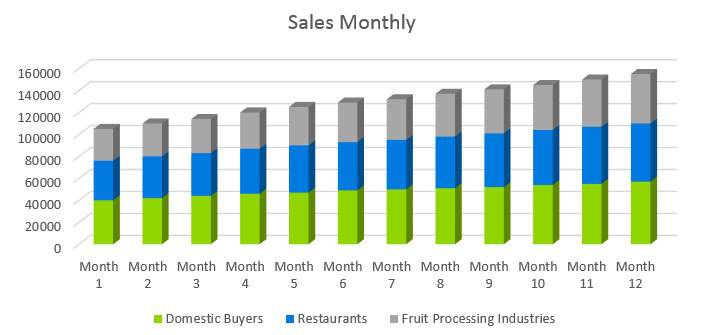
6.4 Sales Yearly
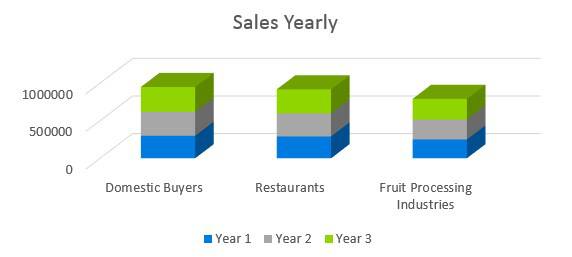
6.5 Sales Forecast
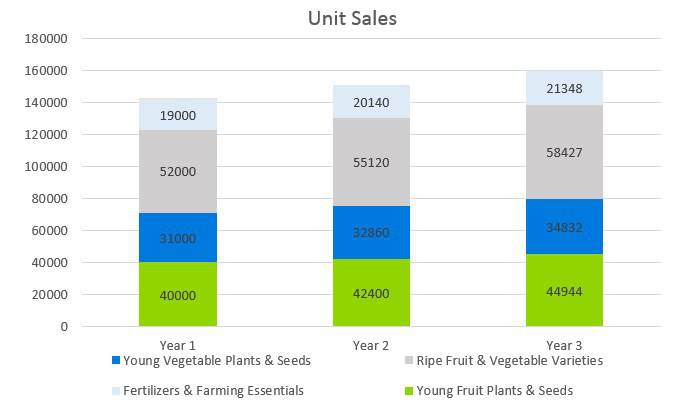
| Sales Forecast | |||
| Unit Sales | Year 1 | Year 2 | Year 3 |
| Young Fruit Plants & Seeds | 40,000 | 42,400 | 44,944 |
| Young Vegetable Plants & Seeds | 31,000 | 32,860 | 34,832 |
| Ripe Fruit & Vegetable Varieties | 52,000 | 55,120 | 58,427 |
| Fertilizers & Farming Essentials | 19,000 | 20,140 | 21,348 |
| TOTAL UNIT SALES | 142,000 | 150,520 | 159,551 |
| Unit Prices | Year 1 | Year 2 | Year 3 |
| Young Fruit Plants & Seeds | $44.00 | $51.04 | $59.21 |
| Young Vegetable Plants & Seeds | $33.00 | $38.28 | $44.40 |
| Ripe Fruit & Vegetable Varieties | $59.00 | $68.44 | $79.39 |
| Fertilizers & Farming Essentials | $64.00 | $74.24 | $86.12 |
| Sales | |||
| Young Fruit Plants & Seeds | $1,760,000.00 | $2,164,096.00 | $2,660,972.44 |
| Young Vegetable Plants & Seeds | $1,023,000.00 | $1,257,880.80 | $1,546,690.23 |
| Ripe Fruit & Vegetable Varieties | $3,068,000.00 | $3,772,412.80 | $4,638,558.78 |
| Fertilizers & Farming Essentials | $1,216,000.00 | $1,495,193.60 | $1,838,490.05 |
| TOTAL SALES | $7,067,000.00 | $8,689,583.20 | $10,684,711.50 |
| Direct Unit Costs | Year 1 | Year 2 | Year 3 |
| Young Fruit Plants & Seeds | $42.00 | $48.00 | $55.00 |
| Young Vegetable Plants & Seeds | $29.00 | $32.00 | $36.00 |
| Ripe Fruit & Vegetable Varieties | $57.00 | $65.00 | $75.00 |
| Fertilizers & Farming Essentials | $62.00 | $71.00 | $81.00 |
| Direct Cost of Sales | |||
| Young Fruit Plants & Seeds | $1,680,000.00 | $2,035,200.00 | $2,471,920.00 |
| Young Vegetable Plants & Seeds | $899,000.00 | $1,051,520.00 | $1,253,937.60 |
| Ripe Fruit & Vegetable Varieties | $2,964,000.00 | $3,582,800.00 | $4,382,040.00 |
| Fertilizers & Farming Essentials | $1,178,000.00 | $1,429,940.00 | $1,729,220.40 |
| Subtotal Direct Cost of Sales | $6,721,000.00 | $8,099,460.00 | $9,837,118.00 |
Personnel plan
When you are writing a fruit farm business plan, you should keep a record of how many persons you will need for a specific task. This will help you in developing your personnel plan and HR management plan.
7.1 Company Staff
Sean will manage and supervise the business himself. However, he will hire the following people:
- 1 Co-Manager to help manage business operations
- 1 Accountant to maintain financial records
- 6 Fruit Farmers to plant and maintain fruits and vegetation
- 2 Store Operators to display company’s sales items
- 2 General Assistants for routine tasks
- 1 Technician to upkeep the machinery
- 1 Web Developer to manage the online presence
- 1 Sales Executive to execute the sales strategy
- 4 Cleaners
- 1 Driver
- 1 Receptionist/ Call Operator
7.2 Average Salary of Employees
| Personnel Plan | |||
| Year 1 | Year 2 | Year 3 | |
| Co-Manager | $14,000 | $15,400 | $16,940 |
| Accountant | $11,000 | $12,100 | $13,310 |
| Fruit Farmers | $65,000 | $71,500 | $78,650 |
| Store Operators | $18,000 | $19,800 | $21,780 |
| Technician | $9,000 | $9,900 | $10,890 |
| General Assistants | $16,000 | $17,600 | $19,360 |
| Web Developer | $7,000 | $7,700 | $8,470 |
| Cleaners | $30,000 | $33,000 | $36,300 |
| Sales Executive | $8,000 | $8,800 | $9,680 |
| Driver | $7,000 | $7,700 | $8,470 |
| Receptionist/ Call Operator | $6,000 | $6,600 | $7,260 |
| Total Salaries | $191,000 | $210,100 | $231,110 |
Financial Plan
When you make a fruit farm business plan you should keep track of the finances involved in all the steps. This will help you in estimating the short-term and long-term costs of running the business. Moreover, by analyzing your cash flows and profit margins your financial plan would give you a detailed insight into how much money you will be having at what time. This will help you in directing your long-term investments and expenses.
Besides giving you a profit and loss analysis, a financial plan will also help you in risk management. In a plant-related business, there is always a good chance of any fault in storing the seeds or plants. Therefore, you must have a financial reserve to cater for any unexpected condition, plant disease, etc.
To assist you in making an accurate financial plan, we’re providing the financial plan developed for Fruit Land.
8.1 Important Assumptions
| General Assumptions | |||
| Year 1 | Year 2 | Year 3 | |
| Plan Month | 1 | 2 | 3 |
| Current Interest Rate | 8.17% | 8.22% | 8.27% |
| Long-term Interest Rate | 8.25% | 8.30% | 8.37% |
| Tax Rate | 23.80% | 24.03% | 24.50% |
| Other | 0 | 0 | 0 |
8.2 Break-even Analysis
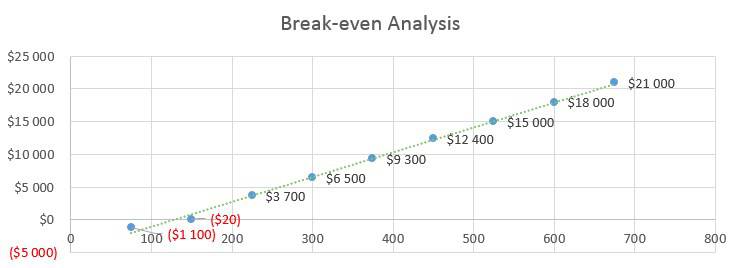
| Break-Even Analysis | |
| Monthly Units Break-even | 5342 |
| Monthly Revenue Break-even | $131,200 |
| Assumptions: | |
| Average Per-Unit Revenue | $234.00 |
| Average Per-Unit Variable Cost | $0.66 |
| Estimated Monthly Fixed Cost | $162,500 |
8.3 Projected Profit and Loss
| Pro Forma Profit And Loss | |||
| Year 1 | Year 2 | Year 3 | |
| Sales | $7,067,000 | $8,689,583 | $10,684,712 |
| Direct Cost of Sales | $6,721,000 | $8,099,460 | $9,837,118 |
| Other | $0 | $0 | $0 |
| TOTAL COST OF SALES | $6,721,000 | $8,099,460 | $9,837,118 |
| Gross Margin | $346,000 | $590,123 | $847,594 |
| Gross Margin % | 4.90% | 6.79% | 7.93% |
| Expenses | |||
| Payroll | $191,000 | $210,100 | $231,110 |
| Sales and Marketing and Other Expenses | $128,000 | $129,000 | $130,000 |
| Depreciation | $2,400 | $2,440 | $2,500 |
| Leased Equipment | $0 | $0 | $0 |
| Utilities | $3,090 | $3,150 | $3,200 |
| Insurance | $1,800 | $1,900 | $2,000 |
| Rent | $4,000 | $4,100 | $4,200 |
| Payroll Taxes | $28,000 | $29,000 | $30,000 |
| Other | $0 | $0 | $0 |
| Total Operating Expenses | $358,290 | $379,690 | $403,010 |
| Profit Before Interest and Taxes | ($12,290) | $210,433 | $444,584 |
| EBITDA | ($12,290) | $210,433 | $444,584 |
| Interest Expense | $0 | $0 | $0 |
| Taxes Incurred | ($2,458) | $42,087 | $88,917 |
| Net Profit | ($9,832) | $168,347 | $355,667 |
| Net Profit/Sales | -0.14% | 1.94% | 3.33% |
8.3.1 Profit Monthly
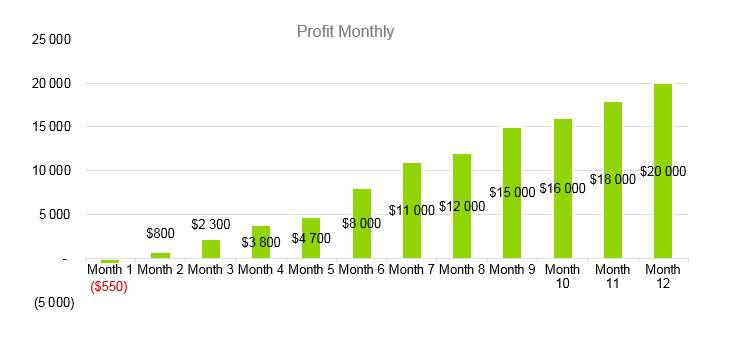
8.3.2 Profit Yearly
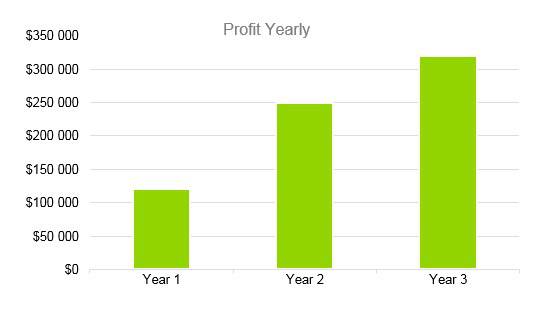
8.3.3 Gross Margin Monthly
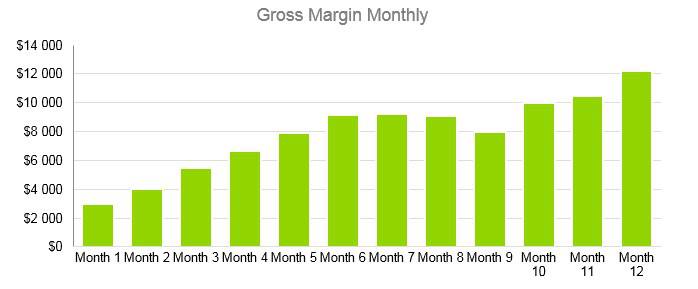
8.3.4 Gross Margin Yearly
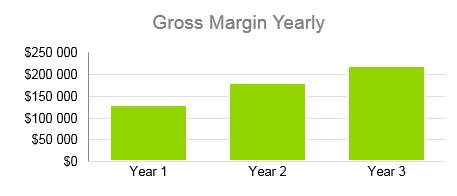
8.4 Projected Cash Flow
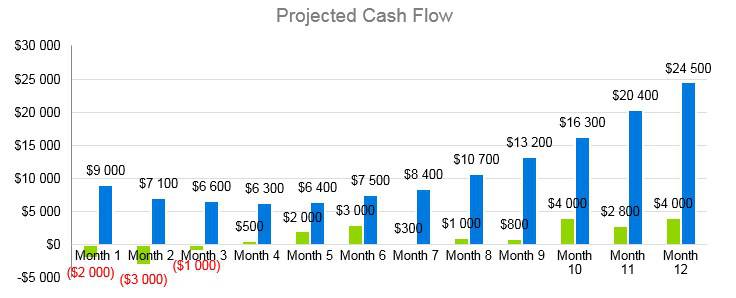
| Pro Forma Cash Flow | |||
| Cash Received | Year 1 | Year 2 | Year 3 |
| Cash from Operations | |||
| Cash Sales | $54,000 | $58,320 | $62,986 |
| Cash from Receivables | $19,000 | $20,520 | $22,162 |
| SUBTOTAL CASH FROM OPERATIONS | $73,000 | $79,570 | $85,936 |
| Additional Cash Received | |||
| Sales Tax, VAT, HST/GST Received | $0 | $0 | $0 |
| New Current Borrowing | $0 | $0 | $0 |
| New Other Liabilities (interest-free) | $0 | $0 | $0 |
| New Long-term Liabilities | $0 | $0 | $0 |
| Sales of Other Current Assets | $0 | $0 | $0 |
| Sales of Long-term Assets | $0 | $0 | $0 |
| New Investment Received | $0 | $0 | $0 |
| SUBTOTAL CASH RECEIVED | $73,000 | $80,000 | $86,000 |
| Expenditures | Year 1 | Year 2 | Year 3 |
| Expenditures from Operations | |||
| Cash Spending | $35,000 | $36,000 | $37,000 |
| Bill Payments | $29,000 | $30,000 | $31,000 |
| SUBTOTAL SPENT ON OPERATIONS | $64,000 | $66,000 | $68,000 |
| Additional Cash Spent | |||
| Sales Tax, VAT, HST/GST Paid Out | $0 | $0 | $0 |
| Principal Repayment of Current Borrowing | $0 | $0 | $0 |
| Other Liabilities Principal Repayment | $0 | $0 | $0 |
| Long-term Liabilities Principal Repayment | $0 | $0 | $0 |
| Purchase Other Current Assets | $0 | $0 | $0 |
| Purchase Long-term Assets | $0 | $0 | $0 |
| Dividends | $0 | $0 | $0 |
| SUBTOTAL CASH SPENT | $65,000 | $67,000 | $72,360 |
| Net Cash Flow | $14,500 | $16,000 | $18,000 |
| Cash Balance | $27,000 | $29,000 | $30,000 |
8.5 Projected Balance Sheet
| Pro Forma Balance Sheet | |||
| Assets | Year 1 | Year 2 | Year 3 |
| Current Assets | |||
| Cash | $278,000 | $311,360 | $342,496 |
| Accounts Receivable | $24,000 | $26,880 | $30,213 |
| Inventory | $4,000 | $4,480 | $4,900 |
| Other Current Assets | $1,000 | $1,000 | $1,000 |
| TOTAL CURRENT ASSETS | $293,200 | $328,384 | $369,104 |
| Long-term Assets | |||
| Long-term Assets | $10,000 | $10,000 | $10,000 |
| Accumulated Depreciation | $17,500 | $19,600 | $22,050 |
| TOTAL LONG-TERM ASSETS | $26,000 | $29,120 | $32,760 |
| TOTAL ASSETS | $299,000 | $334,880 | $376,740 |
| Liabilities and Capital | Year 4 | Year 5 | Year 6 |
| Current Liabilities | |||
| Accounts Payable | $22,000 | $24,640 | $27,695 |
| Current Borrowing | $0 | $0 | $0 |
| Other Current Liabilities | $0 | $0 | $0 |
| SUBTOTAL CURRENT LIABILITIES | $13,200 | $14,784 | $16,617 |
| Long-term Liabilities | $0 | $0 | $0 |
| TOTAL LIABILITIES | $15,000 | $16,800 | $18,883 |
| Paid-in Capital | $30,000 | $32,000 | $33,000 |
| Retained Earnings | $55,100 | $60,059 | $66,065 |
| Earnings | $197,100 | $214,839 | $236,323 |
| TOTAL CAPITAL | $293,400 | $319,806 | $351,787 |
| TOTAL LIABILITIES AND CAPITAL | $308,400 | $334,880 | $376,740 |
| Net Worth | $295,000 | $321,550 | $353,705 |
8.6 Business Ratios
| Ratio Analysis | ||||
| Year 1 | Year 2 | Year 3 | INDUSTRY PROFILE | |
| Sales Growth | 7.12% | 7.89% | 8.74% | 3.00% |
| Percent of Total Assets | ||||
| Accounts Receivable | 9.24% | 10.24% | 11.34% | 9.80% |
| Inventory | 5.62% | 6.23% | 6.90% | 9.90% |
| Other Current Assets | 2.15% | 2.38% | 2.64% | 2.40% |
| Total Current Assets | 150.40% | 151.20% | 152.50% | 158.00% |
| Long-term Assets | 12.00% | 12.10% | 12.20% | 12.00% |
| TOTAL ASSETS | 100.00% | 100.00% | 100.00% | 100.00% |
| Current Liabilities | 4.67% | 4.71% | 4.75% | 4.34% |
| Long-term Liabilities | 0.00% | 0.00% | 0.00% | 0.00% |
| Total Liabilities | 7.54% | 7.60% | 7.67% | 7.38% |
| NET WORTH | 102.03% | 102.85% | 103.79% | 110.00% |
| Percent of Sales | ||||
| Sales | 100.00% | 100.00% | 100.00% | 100.00% |
| Gross Margin | 95.01% | 97.58% | 100.31% | 99.00% |
| Selling, General & Administrative Expenses | 93.73% | 96.26% | 98.96% | 97.80% |
| Advertising Expenses | 1.71% | 1.76% | 1.81% | 1.40% |
| Profit Before Interest and Taxes | 41.07% | 42.18% | 43.36% | 33.90% |
| Main Ratios | ||||
| Current | 36 | 37 | 38 | 32 |
| Quick | 31.2 | 31.4 | 32.185 | 33 |
| Total Debt to Total Assets | 0.18% | 0.18% | 0.18% | 0.40% |
| Pre-tax Return on Net Worth | 74.83% | 74.86% | 74.89% | 75.00% |
| Pre-tax Return on Assets | 94.07% | 98.77% | 103.71% | 111.30% |
| Additional Ratios | Year 1 | Year 2 | Year 3 | |
| Net Profit Margin | 32.94% | 33.96% | 35.01% | N.A. |
| Return on Equity | 55.01% | 56.72% | 58.47% | N.A. |
| Activity Ratios | ||||
| Accounts Receivable Turnover | 7.7 | 7.8 | 7.9 | N.A. |
| Collection Days | 100 | 100 | 100 | N.A. |
| Inventory Turnover | 32.4 | 34.02 | 34.3 | N.A. |
| Accounts Payable Turnover | 16.1 | 16.2 | 16.4 | N.A. |
| Payment Days | 27 | 27 | 27 | N.A. |
| Total Asset Turnover | 2.4 | 2.5 | 2.6 | N.A. |
| Debt Ratios | ||||
| Debt to Net Worth | -0.03 | -0.03 | -0.04 | N.A. |
| Current Liab. to Liab. | 1 | 1 | 1 | N.A. |
| Liquidity Ratios | ||||
| Net Working Capital | $249,000 | $262,944 | $277,669 | N.A. |
| Interest Coverage | 0 | 0 | 0 | N.A. |
| Additional Ratios | ||||
| Assets to Sales | 0.86 | 0.87 | 0.89 | N.A. |
| Current Debt/Total Assets | 1% | 0% | 0% | N.A. |
| Acid Test | 27.4 | 27.6 | 27.8 | N.A. |
| Sales/Net Worth | 2.1 | 2.2 | 2.2 | N.A. |
| Dividend Payout | 0 | 0 | 0 | N.A. |
Hi-Tech in Every Way
The U.S. agriculture fruit farm industry produces millions of tons of grapes, apples, peaches, strawberries, pears, prunes, oranges, lemons, and other non-citrus and citrus fruits. The word ‘agriculture’ may evoke images of farmers with hoes working the fields, but the reality is the modern farm is high-tech in every way, from the planting and harvesting equipment to the software used to track crop production and maintain accounting records.
The fruit farm business plan will discuss success factors like the use of technology to develop a business that has cutting-edge products, production and delivery processes. Following are just some of the topics included in the final document.
- Businesses merged or acquired and the synergy created in the new company
- Management’s experience in modern agricultural techniques
- Food technologies that address nutritional content and taste
- Products that include type of fruits and other crops added to round out the year long production cycle, like vegetables and nuts
- By-products produced like compost that is bagged and sold
- Project income per product
- Business differentiation factors, like organic fruits, combination of traditional and high-tech farming methods, fruits with unique quality associated with local soil and climate, etc.
- Research & Development (R&D) activities that will keep the business on the cutting edge
- Needed facilities, including greenhouse, water supply infrastructure, production plant, storage facility, and office building
- Equipment requirements for planting, harvesting, and preparation of fruit for cold storage or immediate sale
- Sources of customers for products, including farmers markets, food wholesalers, grocery store chains, etc.
These are just some of the important aspects of an agriculture fruit farm. The fruit farm business plan will include all the elements of a successful business, like Executive Summary, management summary, operating plan, marketing plan, and financial projections.
Download Business Plan for an Agriculture Fruit Farm Sample in PDF
OGScapital writer specializes business plan themes such as fountain pepper farm business plan, hydroponics farm business plan, and help write a business plan for investors and help draw up a business strategy plan.




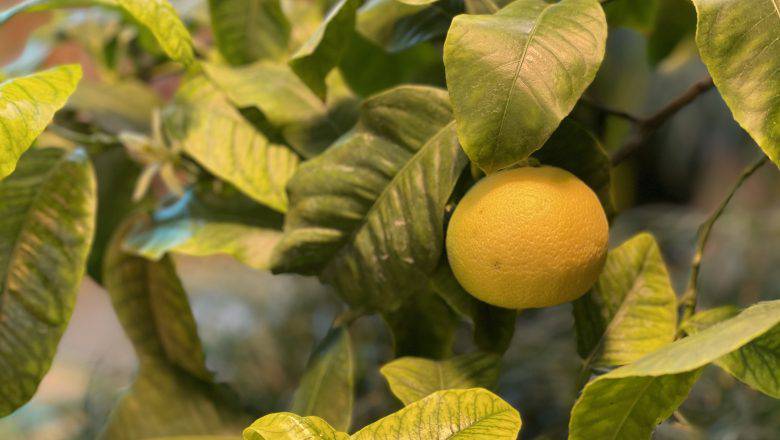





Add comment
Comments (0)